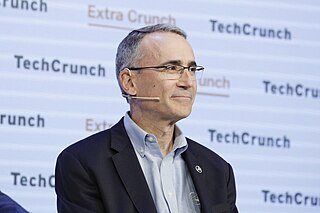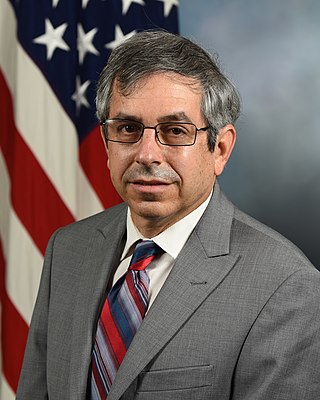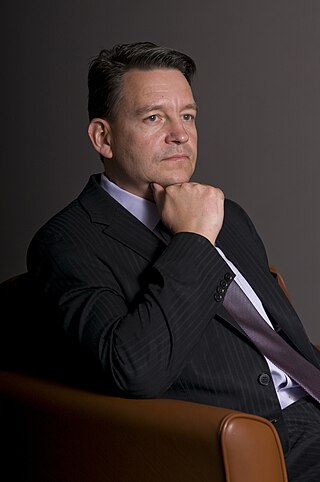
Jeffrey Alan Hoffman is an American former NASA astronaut and currently a professor of aeronautics and astronautics at MIT.

Bruce Edward Melnick is a retired American astronaut and United States Coast Guard officer. Following retirement from NASA and the Coast Guard, he entered the aerospace industry. He served as a vice president with the Boeing Co.'s Integrated Defense Systems group, in charge of Boeing's Florida operations at the John F. Kennedy Space Center (KSC). Melnick retired in 2008 and currently resides on Merritt Island, Florida.

The American Institute of Aeronautics and Astronautics (AIAA) is a professional society for the field of aerospace engineering. The AIAA is the U.S. representative on the International Astronautical Federation and the International Council of the Aeronautical Sciences. In 2015, it had more than 30,000 members among aerospace professionals worldwide.

Charles Elachi is a Lebanese-American professor (emeritus) of electrical engineering and planetary science at the California Institute of Technology (Caltech). From 2001 to 2016 he was the 8th director of the Jet Propulsion Laboratory and vice president of Caltech.

Hans Michael Mark was a German-born American government official who served as Secretary of the Air Force and as a Deputy Administrator of NASA. He was an expert and consultant in aerospace design and national defense policy.

Dava J. Newman is the director of the MIT Media Lab and a former deputy administrator of NASA. Newman earned her PhD in aerospace biomedical engineering, and Master of Science degrees in aerospace engineering and technology and policy all from MIT, and her Bachelor of Science degree in aerospace engineering from the University of Notre Dame. Newman is the Apollo Program Professor of Aeronautics and Astronautics and Engineering Systems at the Massachusetts Institute of Technology and a member of the faculty at the Harvard–MIT Program in Health Sciences and Technology. She is also a MacVicar Faculty Fellow, former director of the Technology and Policy Program at MIT (2003–2015), and has been the director of the MIT Portugal Program since 2011. As the director of MIT's Technology and Policy Program (TPP), she led the institute's largest multidisciplinary graduate research program, with over 1,200 alumni. She has been a faculty member in her home department of Aeronautics and Astronautics and MIT's School of Engineering since 1993.

Robert Channing Seamans Jr. was an MIT professor who served as NASA Deputy Administrator and 9th United States Secretary of the Air Force.
Eugene Edzards Covert was an aeronautics specialist born in Rapid City, South Dakota credited with the world's first practical wind tunnel magnetic suspension system, and was a member of the Rogers Commission. In the 1970s he was the chief scientist of the US Air Force and technical director of the European Office of Aerospace Research and Development.
The Jerome C. Hunsaker Visiting Professor of Aerospace Systems is a professorship established in 1954 by the Massachusetts Institute of Technology (MIT) Department of Aeronautics and Astronautics. It is named after MIT professor Jerome Hunsaker (1886–1984) in honor of his achievements in aeronautical engineering. The visiting professor is expected to deliver the Minta Martin Lecture in several venues in the United States.

Steve Isakowitz is the President and CEO of The Aerospace Corporation assuming the position on October 1, 2016. The Aerospace Corporation is a leading architect for the nation's national security and civil space programs with more than 4,000 employees and annual revenues of $1.1 billion. Isakowitz is a recognized leader across the government, private, space, and technology sectors, having served in prominent roles at Virgin Galactic, the U.S. Department of Energy, NASA, and the White House Office of Management and Budget. He is the co-author of the AIAA International Reference Guide to Space Launch Systems, which received the Summerfield Book Award in 2003.
Value-driven design (VDD) is a systems engineering strategy based on microeconomics which enables multidisciplinary design optimization. Value-driven design is being developed by the American Institute of Aeronautics and Astronautics, through a program committee of government, industry and academic representatives. In parallel, the U.S. Defense Advanced Research Projects Agency has promulgated an identical strategy, calling it value-centric design, on the F6 Program. At this point, the terms value-driven design and value-centric design are interchangeable. The essence of these strategies is that design choices are made to maximize system value rather than to meet performance requirements.

The Purdue University School of Aeronautics and Astronautics is Purdue University's school of aerospace engineering contained within the Purdue University College of Engineering. The school offers BS, M.S., and PhD degrees in aeronautical and astronautical engineering and provides distance graduate education including online MS in Engineering with concentration in Aeronautics and Astronautics and a distance PhD. Its main office and some of its labs are located in the Neil Armstrong Hall of Engineering. As of 2010, the School has awarded an estimated 6% of BS degrees and 7% of PhDs in aerospace engineering in the United States.

Dr. Mark J. Lewis is a senior American aerospace and defense executive with special expertise in hypersonics. He is currently the Executive Director of the National Defense Industrial Association's Emerging Technologies Institute, following his role in the second half of 2020 as the acting US Deputy Under Secretary of Defense for Research and Engineering, and before that the Director of Defense Research and Engineering for Modernization. He was the Chief Scientist of the U.S. Air Force, Washington, D.C. from 2004 to 2008 and was the longest-serving Chief Scientist in Air Force history. He served as chief scientific adviser to the Chief of Staff and Secretary of the Air Force, and provided assessments on a wide range of scientific and technical issues affecting the Air Force mission. In this role he identified and analyzed technical issues and brought them to attention of Air Force leaders, and interacted with other Air Staff principals, operational commanders, combatant commands, acquisition, and science & technology communities to address cross-organizational technical issues and solutions. His primary areas of focus included energy, sustainment, long-range strike technologies, advanced propulsion systems, and workforce development.
Holt Ashley was an American aeronautical engineer notable for his seminal research of aeroelasticity.

Olivier L. de Weck is the Apollo Program Professor of Astronautics and Engineering Systems at the Massachusetts Institute of Technology (MIT). He has authored and co-authored more than 400 peer-reviewed publications. He is a Fellow of the INCOSE and a Fellow of the AIAA. He is the Editor-in-Chief of the Journal of Spacecraft and Rockets. From 2013-2018 de Weck served as the Editor-in-Chief for Systems Engineering, the leading journal of INCOSE. He is best known for contributions to the fields of Systems Engineering, Design optimization, and Space Logistics, where together with colleagues from JPL he coined the term Interplanetary Supply Chain. More recently he has become active in the field of Remote Sensing.
Daniel E. Hastings is an American physicist, currently the Cecil and Ida Green Education Professor and the former director of the Singapore-MIT Alliance for Research and Technology (SMART) at the Massachusetts Institute of Technology. Hastings became head of the Department of Aeronautics and Astronautics on January 1, 2019. He has served as the Chief Scientist of the US Air Force and on many national level boards.

David W. Miller is an American aerospace engineer who is the current Jerome Hunsaker Professor of Aeronautics and Astronautics at Massachusetts Institute of Technology and an elected Fellow of the American Institute of Aeronautics and Astronautics since 2015. He is currently on a leave of absence from MIT to be a VP and the Chief Technology Officer to The Aerospace Corporation. He has worked on multiple NASA projects and served as NASA Chief Technologist.

John Francis McCarthy Jr. was an American scientist and engineer. He worked for the Massachusetts Institute of Technology as director of its Center for Space Research; the National Aeronautics and Space Administration (NASA) as the director of its Lewis Research Center; the United States Air Force, where he served with the Strategic Air Command and as a member of the United States Air Force Scientific Advisory Board; North American Rockwell, where he oversaw the design and development of the Apollo command and service module that took the first men to the Moon, and the S-II of the Saturn V rocket. His work doubled, and in the case of the Lockheed C-5 Galaxy, tripled, the service life of aircraft.

David Y. Oh is an American spacecraft systems engineer and expert in electric propulsion. Oh currently works at the Jet Propulsion Laboratory (JPL) as the NASA Psyche mission Project Systems Engineering Manager. Prior to his role on Psyche, he was the cross-cutting phase lead and lead flight director for the NASA Mars Science Laboratory mission and was recognized in popular media for living on Mars time with his family during the month following the landing of the Curiosity rover.














